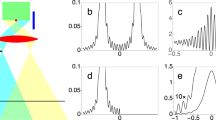Abstract
An experiment has been conducted to test the speculation that “empty” waves suffer attenuation in their propagation relative to waves which carry singularities. This speculation leads to the prediction that the contrast of interference fringes should decrease exponentially with free independent path length. A double-slit experiment has been carried out in which the distance between the slits and the observation plane has been varied over a wide range. High contrast interference fringes have been recorded and the contrast measured as a function of distance between the slits and the observation plane. No convincing evidence is found for attentuated “empty” waves.
Similar content being viewed by others
References
R. P. Feynman,Proceedings, Second Berkeley Symposium on Mathematical Statistics and Probability (University of California Press, Berkeley, 1951).
X. Y. Zou, L. J. Wang, and L. Mandel,Phys. Rev. Lett. 67, 3 (1991).
G. Lochak,The Wave-Particle Dualism, S. Diner, D. Fargue, G. Lochak, and F. Selleri, eds. (Reidel, Dordrecht, 1984), pp. 1–25.
J.-P. Vigier,Found. Phys. 21 (2) (1991).
M. Bozic, and Z. Maric,Phys. Lett. A 158, 33–42 (1991).
C. Philippidis, C. Dewdney, and B. J. Hiley,Nuovo Cimento 52B, 15 (1979).
C. Philippidis, D. Bohm, and R. D. Kaye,Nuovo Cimento 71B, 75 (1982).
F. Selleri,Found. Phys. 12 (11) (1982).
F. Selleri,Quantum Paradoxes and Physical Reality, A. van der Merwe, ed. (Kluwer Academic, Dordrecht, 1990), Chap. 4.
J. R. Croca, inThe Concept of Probability, E. I. Bitsakis and C. A. Nicolaides, eds. pp. 143–158 (Kluwer Academic, Dordrecht, 1989).
J. R. Croca,Found. Phys. 17, 971 (1987).
J. R. Croca, A. Garruccio, and F. Selleri,Found. Phys. Lett. 1, 101 (1988).
F. Selleri,Nouvo Saggiatore (Boll. Soc. It. Fisica) 4, 22 (1988).
Y. Koh and T. Sasaki, inMicrophysical Reality and Quantum Formalism, A. van der Merwe, F. Selleri, and G. Tarozzi, eds. (Kluwer Academic, Dordrecht, 1988).
P. Grangier, G. Roger, and A. Aspect, inNew Techniques and Ideas in Quantum Measurement Theory, D. Greenberger, ed., Ann. New York Acad. Sci.480, 98 (1986).
L. Janossy, and Z. Naray,Suppl. Nuovo Cimento 9, 588–598 (1958).
J. D. Franson, and K. A. Potocki,Phys. Rev. A 37, 2511 (1988).
R. D. Prosser,Int. J. Theor. Phys. 15, 181 (1976).
S. Jeffers, R. D. Prosser, G. Hunter, and J. Sloan, “Classical electromagnetic theory of diffraction and interference: Edge, single and double slit solutions,” inWaves and Particles in Light and Matter, A. Garuccio and A. van der Merwe, eds. (Plenum, New York, 1994).
X. Y. Zou, T. Grayson, L. J. Wang, and L. Mandel,Phys. Rev. Lett. 68 3667–3669 (1992).
Author information
Authors and Affiliations
Rights and permissions
About this article
Cite this article
Jeffers, S., Sloan, J. An experiment to detect “empty” waves. Found Phys Lett 7, 333–341 (1994). https://doi.org/10.1007/BF02186683
Received:
Revised:
Issue Date:
DOI: https://doi.org/10.1007/BF02186683




